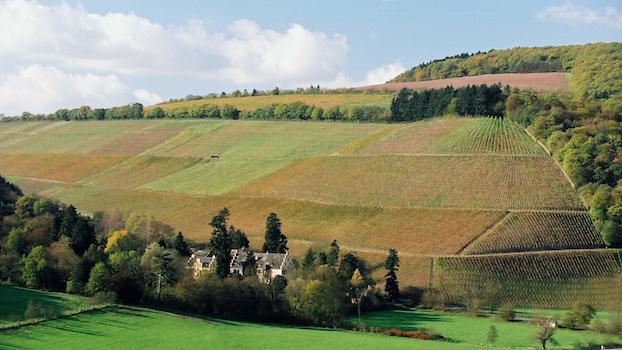Browse using the new Vinous website now. Launch →
Printed by, and for the sole use of . All rights reserved © 2015 Vinous Media
Rescuing Ruwer Riesling in 2014 ... and Beyond
BY DAVID SCHILDKNECHT | SEPTEMBER 14, 2016
The Ruwer is a tiny Mosel tributary that enters the Mosel just downstream from Trier. Only its last three miles are flanked by vines, and then sporadically, representing a surface area far smaller than it was in the mid-20th century, let alone 175 years ago when Karl Marx, himself the inheritor of family vine acreage at the edge of today’s Maximin Grünhaus Herrenberg, penned an impassioned plea on behalf of his beleaguered fellow wine growers. But even before the late 19th-century rise of Mosel Riesling to international consciousness and prestige, the few top blue and red slate sites along this stream were already locally renowned, in particular the monopole holdings of Carthusian monks (Karthäuserhof) and of the Abbey of St. Maximin in Trier (Maximin Grünhaus), as well as the Kaseler Nies'chen.
During the 1980s and early 1990s, the von Schuberts at Maximin Grünhaus, with their cellarmaster and vineyard manager Alphonse Heinrich, consistently delivered Rieslings whose complexity and ageworthiness few if any other German estates could match. A few hundred yards away, Peter Geiben got serious about quality and in 1988 began rendering Rieslings that occasionally challenged those of his more famous neighbor. And Christoph Tyrell, after inheriting responsibility for the Karthäuserhof in 1986, brought the quality of that estate’s wines back into line with its exalted reputation. At that time, I regularly referred to the Ruwer as among the most consistent sources of Riesling quality anywhere in the world. Two other principle landholders—Reichsgraf von Kesselstatt (headquartered here) and Erben von Beulwitz (acquired in 1982 by local restaurateur and hotelier Herbert Weis)—did their part to uphold high standards, although Trier’s ecclesiastical estates, long important players here, were by then in decline.

The Maximin Grünhaus Herrenberg and (at right) Abtsberg vineyards have recovered their place at the apex of Ruwer viticulture. Proprietor Carl von Schubert, who this year returned his family’s estate to the VDP fold, has just been elected its Mosel chapter’s president, following a sudden brouhaha within its ranks.
Today, the von Schubert estate has rebounded after a dip in quality during Alphonse Heinrich’s last years and following his 2001 departure. But over the past decade, performances by the other Ruwer vineyard holders have too often disappointed and in some instances gradually declined.
Some blame for recently often lackluster Ruwer quality can certainly be laid at the door of Mother Nature, and 2014 is a case in point, this having been among the sectors of Riesling Germany most rained on in September and October and consequently most challenged by rot and rampaging fruit flies. In my upcoming report on vintage 2015, there will be much to report on from the Karthäuserhof, whose personnel have been reshuffled, and I’ll also cover the wines of Marco van Elkan’s eponymous micro-estate, whose wines only recently came to my attention. This lovely and distinctive little sub-region of the Mosel could use some newly motivated talent riding to its rescue.
A Note on Labeling
In 2006, the Saar and Ruwer officially ceased being part of a growing region known as “Mosel-Saar-Ruwer” (whereby growers had often underlined or bold-highlighted on their labels the place name that was relevant to the wine at hand) and were subsumed under “Mosel.” The name “Saar” has since then been permitted a return to wine labels. But that cannot happen with “Ruwer” under current German Wine Law because “Ruwer” is also the name of the Trier suburb where the river empties into the Mosel, and the name is therefore protected for wines from the minuscule vine acreage of that specific community, never mind the fact that no grower currently bottles a wine labeled for that village. It must be admitted that until the post-World War II emergence of “Mosel-Saar-Ruwer” as a regional designation, Rieslings from the Ruwer—notwithstanding their geographic and stylistic distinctiveness—were referred to as “Mosel wines” rather than enjoying the sort of separate identity that traditionally accrued to “Saar.”
You Might Also Enjoy
The Saar 2014: Stress for Success, David Schildknecht May 2016
2014 Germany: Riesling Resists Rain on the Rhine, David Schildknecht May 2016
Austria 2014: A Catastrophe? Not Qualitatively!, David Schildknecht February 2016
2013: A Great Vintage for Austrian Riesling and Grüner Veltliner, David Schildknecht November 2015
